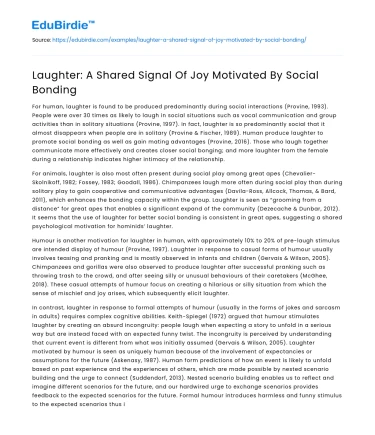For human, laughter is found to be produced predominantly during social interactions (Provine, 1993). People were over 30 times as likely to laugh in social situations such as vocal communication and group activities than in solitary situations (Provine, 1997). In fact, laughter is so predominantly social that it almost disappears when people are in solitary (Provine & Fischer, 1989). Human produce laughter to promote social bonding as well as gain mating advantages (Provine, 2016). Those who laugh together communicate more effectively and creates closer social bonging; and more laughter from the female during a relationship indicates higher intimacy of the relationship.
For animals, laughter is also most often present during social play among great apes (Chevalier-Skolnikoff, 1982; Fossey, 1983; Goodall, 1986). Chimpanzees laugh more often during social play than during solitary play to gain cooperative and communicative advantages (Davila-Ross, Allcock, Thomas, & Bard, 2011), which enhances the bonding capacity within the group. Laughter is seen as “grooming from a distance” for great apes that enables a significant expand of the community (Dezecache & Dunbar, 2012). It seems that the use of laughter for better social bonding is consistent in great apes, suggesting a shared psychological motivation for hominids’ laughter.
Save your time!
We can take care of your essay
- Proper editing and formatting
- Free revision, title page, and bibliography
- Flexible prices and money-back guarantee
Humour is another motivation for laughter in human, with approximately 10% to 20% of pre-laugh stimulus are intended display of humour (Provine, 1997). Laughter in response to casual forms of humour usually involves teasing and pranking and is mostly observed in infants and children (Gervais & Wilson, 2005). Chimpanzees and gorillas were also observed to produce laughter after successful pranking such as throwing trash to the crowd, and after seeing silly or unusual behaviours of their caretakers (McGhee, 2018). These casual attempts of humour focus on creating a hilarious or silly situation from which the sense of mischief and joy arises, which subsequently elicit laughter.
In contrast, laughter in response to formal attempts of humour (usually in the forms of jokes and sarcasm in adults) requires complex cognitive abilities. Keith-Spiegel (1972) argued that humour stimulates laughter by creating an absurd incongruity: people laugh when expecting a story to unfold in a serious way but are instead faced with an expected funny twist. The incongruity is perceived by understanding that current event is different from what was initially assumed (Gervais & Wilson, 2005). Laughter motivated by humour is seen as uniquely human because of the involvement of expectancies or assumptions for the future (Askenasy, 1987). Human form predictions of how an event is likely to unfold based on past experience and the experiences of others, which are made possible by nested scenario building and the urge to connect (Suddendorf, 2013). Nested scenario building enables us to reflect and imagine different scenarios for the future, and our hardwired urge to exchange scenarios provides feedback to the expected scenarios for the future. Formal humour introduces harmless and funny stimulus to the expected scenarios thus inducing laughter, and such laughter is therefore thought to be a human automorphy (Preuschoft, 1992).
However, McGhee (2018) observed incongruity-elicited laughter in apes with systematic sign language training. A gorilla Koko was shown a picture of a bird, she then signed “that me” and “Koko bird” to the caretaker. When the caretaker express confusion over this statement, she signed “fake bird” in confession, followed by a series of laughter. This indicates that Koko is capable of understanding the humour of treating what is known (“Koko gorilla”) as something incongruent (“Koko bird”). The author concluded that apes appeared to understand the absurdity of treating the object as something at odds with reality. But the laughter may simply be the result of a mischief joy Koko experienced from teasingly play with the caretaker. There is no evidence of Koko knowing what is expected from her thus manipulating her language in a humorous way to evoke laughter from others. Theres is also little evidence of other animals laughing in response to absurd incongruity.
So overall, both human and animals laugh during social situations to enhance bonding, and both tend to laugh at hilarious situations to express joy, but adult humour in human that involves nested scenario building is unique to human.






 Stuck on your essay?
Stuck on your essay?

